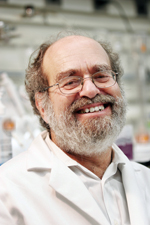What is chemist Irv Epstein doing NOW?
He talks about the possibilities of building a chemical computer, explains his fascination for pattern formation, and reflects on Science Posse's first year

Irv Epstein
Irving Epstein is the Henry F. Fischbach Professor of Chemistry. His research focuses on oscillatory chemical reactions, spatial pattern formation, dynamical systems and neurobiology. He is the recipient of a prestigious Howard Hughes Medical Institute grant, which he used to found Brandeis’ Science Posse, a merit-based scholarship program that encourages students to pursue the sciences.
BrandeisNOW: What are you working on right now?
Irv Epstein: I’m trying to write a paper and possibly put together a grant proposal about some work we’ve been doing on coupled chemical oscillators. These are reactions where concentrations periodically increase and decrease. We have figured out a way to build them into little bubbles of water that float in oil, and the bubbles talk to each other via molecules that move through the oil. They make an interesting analog of the behavior of neurons in brains, in that they oscillate between different states and they’re able to transmit information to each other. We’re trying to figure out how best to present this work and how to carry it further.
BrandeisNOW: Why did you decide to focus on this area?
IE: We’ve been studying these reactions for a number of years and they’re very interesting scientifically, but it just seemed to be an academic curiosity. But recently, after talking to colleagues in neuroscience and physics, we’ve begun to think about more practical applications, which might include even building a chemical computer with these things.
BrandeisNOW: Where are you in the research process at this point?
IE: I’d say this aspect is more towards the beginning, and we’re beginning to tool up to do more sophisticated experiments. We’ve got some preliminary experiments, but now we need to make them a little more complex.
BrandeisNOW: You mentioned the possibility of using what you discover through this research to build a chemical computer; can you tell me more about that, and what other practical applications may be out there?
IE: It’s always hard to say with basic research where it’s going to end up, but I would hope that we’d be able to shed some light on how functions like learning and memory work in actual brains, and possibly also to develop new approaches to computation - such as the idea of a chemical computer. Something a little bit different from your standard digital computer, that maybe mimics the way living brains work.
BrandeisNOW: Do you ever apply something you’ve gleaned from basic in-class experiments to these more complex experiments that you’re working on outside of the classroom?
IE: Occasionally you do think about a phenomenon or a principle in a different way when you’re figuring out how best to present it to a class that hasn’t seen it or thought about it before, and it does very often help the research and make us think about things in a new light.
BrandeisNOW: Are you collaborating with anyone on your current research?
IE: I’m actually collaborating with Seth Fraden in physics, and I get some enlightenment about neuroscience from Eve Marder in biology. So it’s a very collaborative, sort of interdisciplinary area.
BrandeisNOW: How long do you think this research will take?
IE: An individual experiment probably takes a few hours, but designing an experiment can take weeks, if not months, if you have to build new equipment, and the whole project, depending on how successful it is, could actually go on for several years.
BrandeisNOW: Are there any other future experiments that you’re thinking about right now?
IE: We’re very interested in the phenomenon of pattern formation. Think of having a Petri dish full of red liquid, and then spontaneously, a blue spot appears somewhere in the dish and then expands. So now I’ve got a disc of blue. The center of the disc then turns back to red, so now I’ve got a ring of blue and now more rings start to form inside the original ring, and so forth. In other cases spirals or stripes may form. A lot of these patterns in relatively simple chemical reactions look like patterns that you see in nature on the coats of animals or if you image the calcium concentration in a developing frog egg, and so we’re trying to understand how patterns arise and whether these phenomena in chemical systems will give us insight into patterns in biological systems.
BrandeisNOW: Outside of your research, you’re involved with the Brandeis Science Posse. This is the program’s first year. How are things going?
IE: Very well. The students are all having a great time at Brandeis and doing extremely well academically. The majority of them made the dean’s list last semester. Many of them are working in faculty research labs on research projects, and they still have found time to get involved in all sorts of clubs and activities. Overall, it’s been a real success so far, and now the students are starting to think of summer jobs and whether they’re going to go do research in labs back home or maybe somewhere in a different part of the country. They’re doing great.
BrandeisNOW: And what about the second science posse that will come to Brandeis next year?
IE: We selected the second group in December. They have begun training with the Posse Foundation in New York City. They are going to be visiting Brandeis for a two-week boot camp where we try to give them a sense of what science at Brandeis is really like. That will be in June. They also seem to be a great group, and we’re looking forward to having them on campus.





